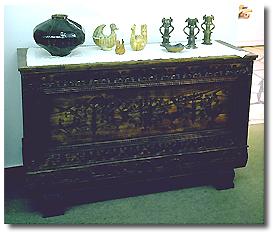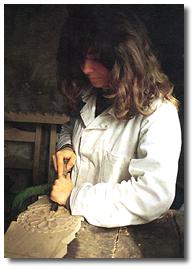Sardinian handicrafts, as we mentioned
above, were made throughout the centuries for everyday use. They were created by the ancient
creativity or by the popular imagination and have become the cultural heritage of well defined areas
on the Island. What we have said above applies equally to the craftsmen who work in wood, metal and
who make jewelry.
|
In the humble rural houses there was
space for very little furniture. There was only the most essential and very simple furniture as one
would expect from a poor rural traditional environment. There was one exception: the trunk. It was
richly carved and had an essential place in the house. This trunk acted as the casket and
"tabernacle" of the family because it held the bride’s outfit. The major or minor
richness of the family could be seen in the trunk’s decorations. The mostly utilized wood was
the chestnut, which was abundant in the woods in Barbagia. Sometimes walnut and oak were also used.
|
|

|

|
|
The central panel was originally smooth
or very simply decorated.
The craftsmen who made these trunks also craved designs of geometrical
or floral patterns or other patterns based on nature such as stylized birds and the sun. Among the
best known areas for these trunks are Desulo, Aritzo, Santulussurgiu, Paulilatino and Isili. There
are also some carvers in Cagliari, Buddusò and Sassari.
Among the other products, chairs deserve a special mention. The straw-bottomed chairs from Assemini
are elegant and functional. They are made from white wood and decorated with red and green designs of
the pomegranate. Pompous and Spanish in design are the chairs of Catalan origin, with their engraved
red or blue or green and gold enameled backs.
|
|